Everything you need to know about home sheds
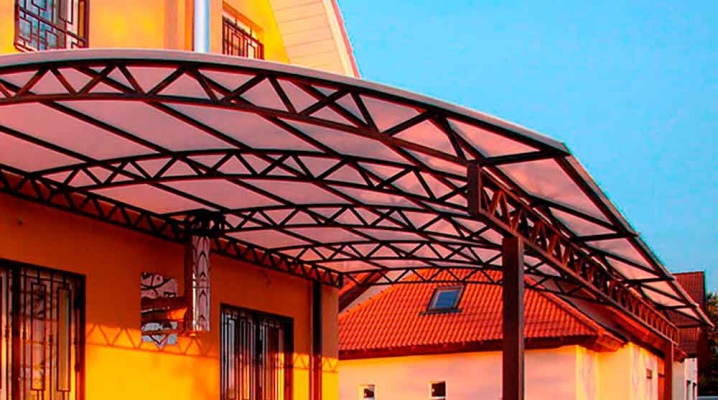
Many owners of country houses dream of a covered porch with a canopy. This is a utilitarian extension that opens up many possibilities, rather than just an open and sometimes useless wide porch. For example, an area under a canopy can be made a summer dining room that protects households from rain and annoying sun. In addition, organizing such a canopy is not the most difficult enterprise.
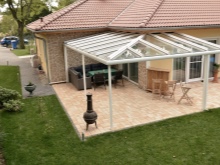
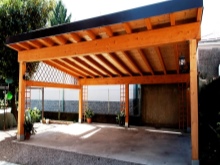
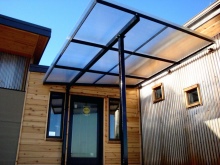
Peculiarities
A canopy attached to the house in the country is very convenient in 99% of cases. If such a structure covers a considerable adjoining area, the renovated site will acquire economic tasks. Under a canopy, for example, it will be possible to make a firewood, store tools, crops from your garden, etc. The household part (the same dining room) is simply taken out of the house into the open air.
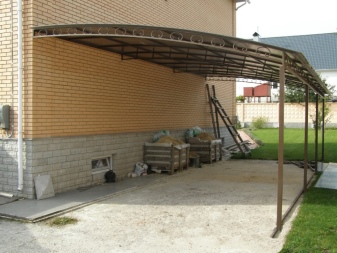
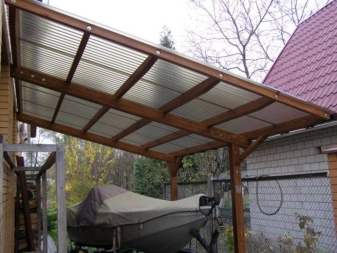
The main task of the canopy is to protect it from bad weather. Even a table standing under a canopy will not be the object of an attack by dust, which can rise in a dry wind.
In addition, such a device looks modern, stylish and often transforms a simple country house. As a rule, not all country houses can boast of a large footage, therefore, if part of a functional interior can be taken outside the house, this is always a smart decision.
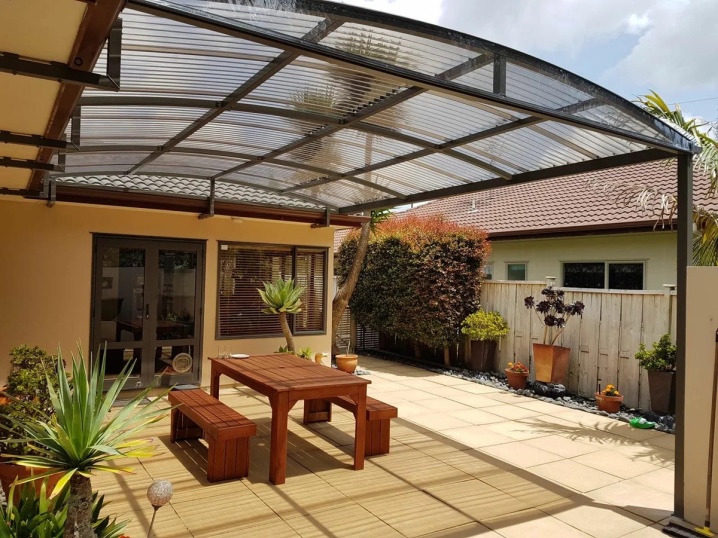
Canopies are different, but almost all of them are united by one feature. - on one side they are attached to the load-bearing facade wall, on the other - they stand on their own supporting structure. But this feature is very beneficial for installation. The attached shed will become part of the building, so it should not be alien to its exterior. And this can be achieved in different ways. For example, by repeating the slope of the main roof or by using the same roofing material. Or you can go the other way and maintain the dimensions, shapes, and features inherent in the style.
Usually an attached canopy is utilitarian either a terrace or a veranda, but classic objects are increasingly being chosen as an object of copying.
They are no longer perceived as elements of country houses from Western magazines, and borrowing such samples even for typical modest country houses only benefits the renovation of the latter.
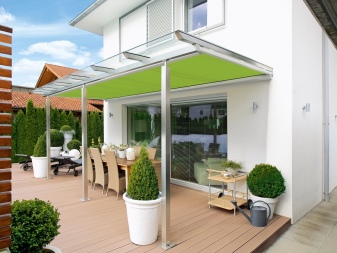
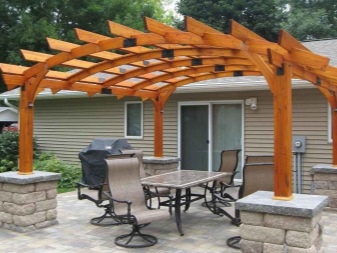
Description of species
Sheds may differ structurally or have differences associated with the method of installation.
By construction type
One of the most popular options is a one-slope canopy attached to one wall. This option assumes that the roof rafters with one side hold the emphasis on the wall, and the other - on the pillars of the support. And this is a great extension for DIY installation. Even an inexperienced summer cottage builder must cope with it.
Other options are as follows.
- Single-slope structures attached to two walls. And this is also not a rare case, in particular, if the entrance to the house is corner. The rafters will be with an emphasis on the wall and supports, one support will be the other wall.
- Gable models attached to the wall. The rafters in this situation hold an emphasis on the ridge girder and the post top harness, which is laid from the wall. For installation, this version of the adjacent structure is heavier.
- Arched, domed, hipped roof canopies and canopies of other complex shapes. This option is undoubtedly very good, but the design of such awnings is difficult for self-assembly. Better with it professional builders and purchased ready-made factory structures.
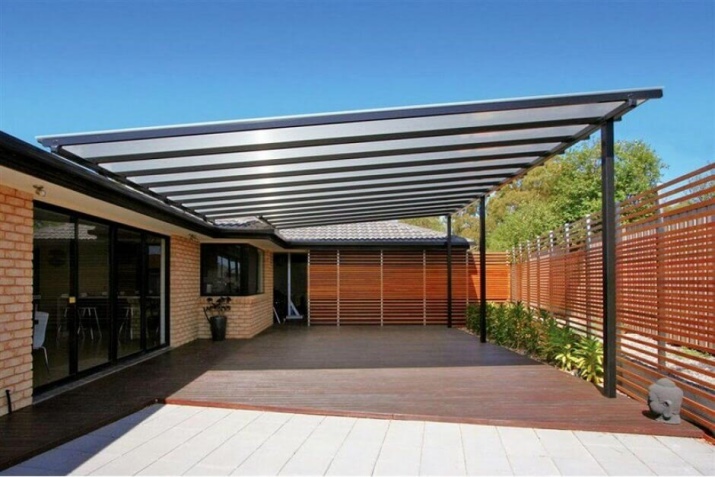
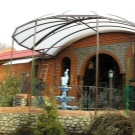
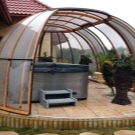
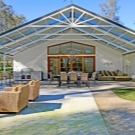

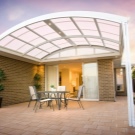
Models with a curly roof are always a complex rafter system, that is, you will have to contact craftsmen with extensive experience in such construction. But they cope not only with a simple straight canopy, but also with a semicircular, curly canopy equally well. Although the budget for building a shed in this case will seriously increase. Even if the adjoining shed is attached to a small wooden country house.
Before choosing the design of your canopy, you need to understand what result the calculation is for: canopies can be covered, as closed as possible from the street or partially open.
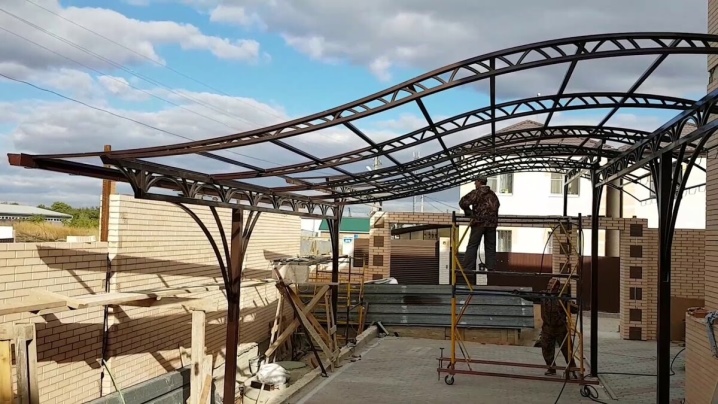
Open means a roof that will keep the rain out - suitable for an entrance lobby, a pretty terrace, a parking lot. Semi-closed canopies provide for a deaf parapet, openings will be closed with dense curtains, lattice or even soft glass. Sometimes the openings are covered with climbing plants, grapes, for example. This solution is suitable for a terrace and a gazebo. Well, under the roofed we mean glazed buildings - we are talking about verandas, corridor and greenhouse solutions.
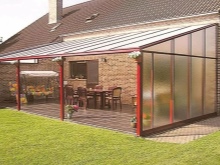
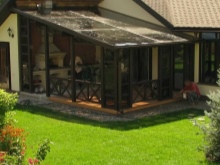

By installation method
Canopies are free-standing, and if so, it is first decided what size it will be. If it is decided to make a canopy near the path next to the house, the width of the canopy will be equal to the width of the path. Therefore, from its opposite edge from the house, you need to put marks indicating the localization of the racks. In parallel, the same marks are made to them near the house. They correspond to the required number of supports. The span between paired racks is limited only by the bearing potential of the bars connecting them into a single object. Supports-pillars placed from the outer part of the path are placed lower in height than the opposite ones. This is how the angular slope of the future canopy will be formed.
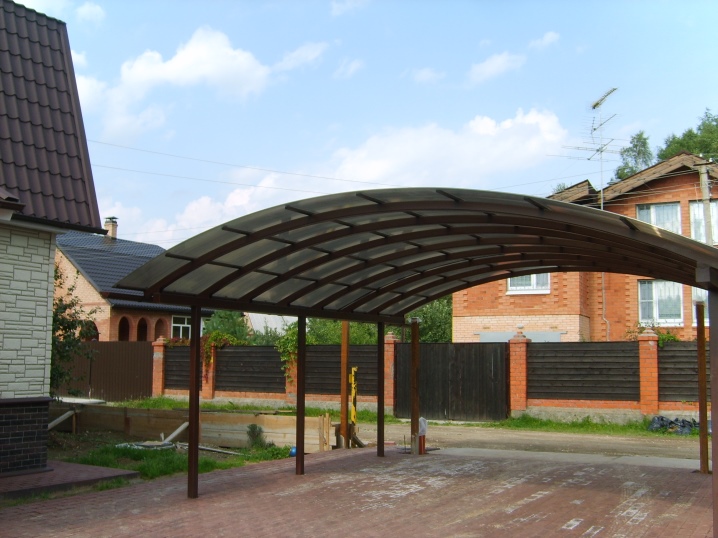
Under the racks, you almost always have to dig holes of 70 cm, and there the racks are inserted and concreted. But this only applies to metal posts. If they are made of beams, a columnar foundation is poured under them, where metal parts for the bookmark will be placed. Then they will attach the pillars to them. After the installation of the racks, their strapping follows, that is, the laying and fastening of the rafter legs and, of course, the battens. But such a project for installing a canopy still happens less often than an extension canopy.
In this case, racks are placed on the outer part of the territory (path), but the opposite rafter parts will be attached to the wall.

Fastening can be carried out using:
- brackets - special fastening elements made of iron sheets, they are fixed to the wall of the building, and then a rafter leg is inserted into a special base and fixed;
- beams - to the wall, parallel to the canopy, installation is either a beam or a thick board, the rafter legs will rest on it (and they are already fixed to the support beam with self-tapping screws and fasteners-profiles with perforations);
- consoles - grooves are made in the wall, repeating the rafters, the console ends are inserted into them, but this method is now actually not used.

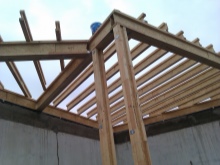
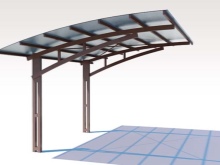
When the issues with the type of design and installation method are resolved, it's time to start calculating the materials.
Materials (edit)
There are a lot of options, but the most common ones should be considered. The whole building is a frame and a roof.
Frame
The basis for the canopy is traditionally made of concrete, wood, metal, stone, brick. What will be the choice depends on the exterior of the house. Wooden devices will be the most obvious in terms of choice: such material is easy to process with a household tool, that is, professional skills from the builder will not be required. This option always looks noble, harmonious with the landscape. But you need to be prepared for the fact that the structure of the boards is afraid of external aggressive conditions.
Therefore, it will be necessary to thoroughly saturate the tree with protective compounds in order to exclude fire hazardous situations, as well as the impact on the tree of precipitation and various pests.

Metal awnings are certainly no less popular.These can be prefabricated, prefabricated aluminum products, which often include an awning roof. Or it can be welded structures made of a round pipe or metal profile. Also not uncommon in this category are welded stainless steel extensions. These are wrought-iron awnings.
But working with metal on your own is much more difficult than working with wood. Special expensive equipment will also be required. The big enemy of the metal frame is rust, therefore all structural parts are primed, cleaned, crumbled. And the material also tends to quickly heat up and cool down, therefore, the railing to the canopy (if a parapet is provided) is still better to be made of wood.
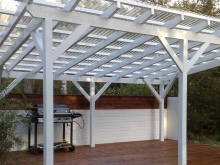

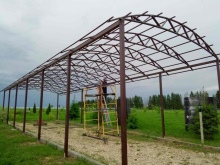
Sheds made of concrete, brick and stone are always more massive and even outwardly more stable structures. They are planned even at the moment when the idea of erecting a canopy enters the sketch phase. But more often they are built in parallel with the house, that is, the roof of the house and the shed in this case will be the same. But if it is decided to carry out an extension with a canopy later, it would be necessary to carefully think over the foundation with a reference.
Many experts agree that it is not worthwhile to perform a rigid hitch for two buildings at once. Nevertheless, the buildings are unbalanced, and soil heaving can also come into force, which is fraught with various cracks and even destruction.


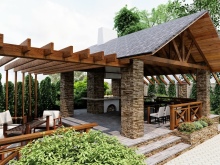
Roof
Ideally, the roof of the canopy is made, like the roof of the house - the material is the same. True, it is impossible to say that this is expedient in each case. In particular, if the canopy is small and is not done at the time of building the house. A popular roofing option for many summer residents today is a carbonate canopy, or, to be more precise, cellular polycarbonate 6-8 mm thick. This material allows you to work quickly and organize a practical result. You can choose a color without any problems to fit into a modest budget. And for beautiful arched structures, for example, this is always a win-win option.
If the roof is single-pitched or gable, profiled sheet, ondulin, ordinary slate, metal tiles, roofing felt are often used - the materials are standard.
If it is decided to make the roof soft, you need a continuous sheathing of plywood with moisture-resistant properties, and also, as an option, slats, edged boards, the same bars, etc.
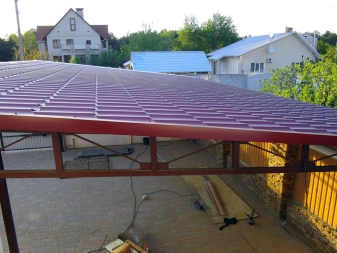
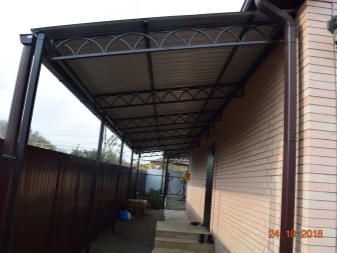

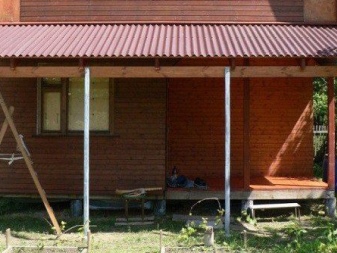
How to do it yourself?
It is not difficult to consider how to build a canopy relatively quickly and, in principle, cheaply, using the example of a wooden structure located along the wall. She has a roof in one slope and a strip foundation.
Building a canopy - step by step instructions.
- Work always begins with a project, a drawing, but if all this has already been selected, it is time to start clearing the site. The fertile soil layer will have to be removed, pegs driven around the perimeter, as well as in those places where there will be load-bearing elements.
- Then everything is standard: pull the rope, adjust the geometry. According to the marking, trenches are dug (depth - 70 cm), 10 cm crushed stone is poured onto the bottom, sand in the same amount, a pillow is rammed.
- On the pillow, you need to knit a reinforcing frame made of corrugated rods. In the corners, 3-4 rods are driven into the ground, horizontal reinforcement is attached to them. Everything is fixed with a knitting wire.
- The lathing is made of edged boards or plywood, which you can soak yourself with machine oil. It is strengthened with slopes, then the structure must be checked with a level. The foundation part can be poured with concrete.
- Now it's time to take a break - after 28 days, the concrete will stand up completely, the crate will be removed, the bottom will be covered with geotextiles. An alternative would be roofing material. The joint moments should be correctly overlapped by 10-25 cm.
- Roofing sheets are laid on the tape with the passage of wooden beams. A bar 150 by 150 cm is treated with antiseptic compounds, refractory agents. It fits on the foundation, while the logs are attached with galvanized corners.
- The visible section of the foundation can be decorated with an artificial stone, and roofing material can be spread over the lags on top.
- Lay the floor with a well-edged board 5 cm by 15 cm with a 2 mm bevel around the edges. This is attached to special studs with a 2mm gap between the canvases.
- Next to the wall, and also on the outside of the hinged project, pillars of a 15 by 15 cm beam are installed, they need to be attached with anchor bolts.
- The strapping is carried out with the same bar along the top of the head supports. The fastening goes to the structure on anchors, with the help of a horizontal beam, the load is distributed along the load-bearing wall.
- It's time to start laying the rafter beam, in pairs, thereby articulating the outer pillar with the inner one. The joints are reinforced with slopes. The inner edge of the rafter leg keeps an emphasis on the beam, the outer edge will go beyond the strapping by 3 cm. The fastening goes to the corners or the slide.
- To organize the rafter system, you can use an edged board with dimensions of 15 by 4 cm. Do not forget that after assembly, the level and plumb line must be checked for the vertical / horizontal of the frame part.
- A transverse lathing is made from a bar, fixing the lathing - with nails or self-tapping screws. The optimal dimensions of the bar are 5 by 5 cm, 6 by 6 cm.
- The frame will have to be primed, varnished or colored oil.
- Above is the installation of polycarbonate. The sheets are joined with special strips, and are attracted to the timber by means of thermal washers.
- Openings (if the project requires it) can be stitched with glass or, which is easier, with molded polycarbonate.
Also, a canopy adjacent to the house can be really decorated with carvings or beautiful lattice structures. And no gazebo is needed: instead of it, the canopy will perform the same functions.
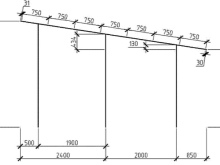
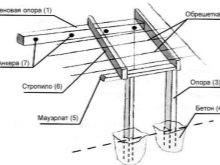
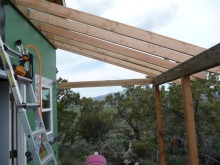
Beautiful examples
Examples of finished projects illustrate the above. They only provoke active summer residents to bold decisions. Examples for inspiration.
- The large polycarbonate canopy completely transforms the look of the house. In this case, it balances the space and creates a wonderful area for a summer dining room. It can also be combined with a greenhouse.
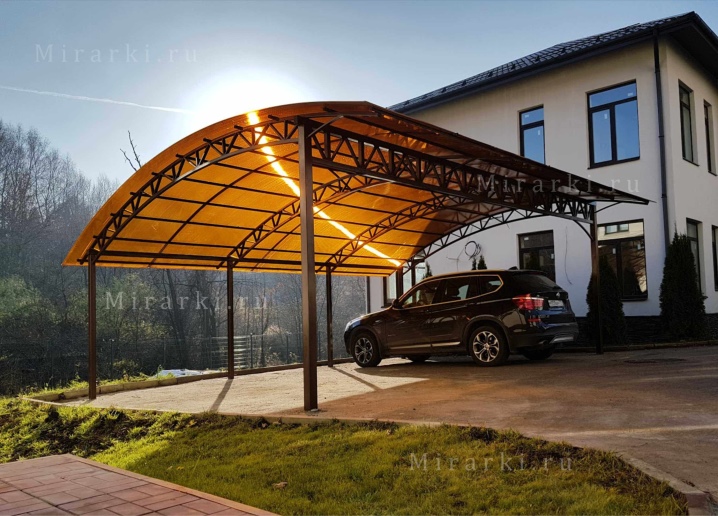
- Another solution, the roof for the canopy is chosen transparent, but at the same time it will protect from bad weather or heat. Such transparent roofs are often chosen if you want to preserve the visual airiness and lightness of the structure.
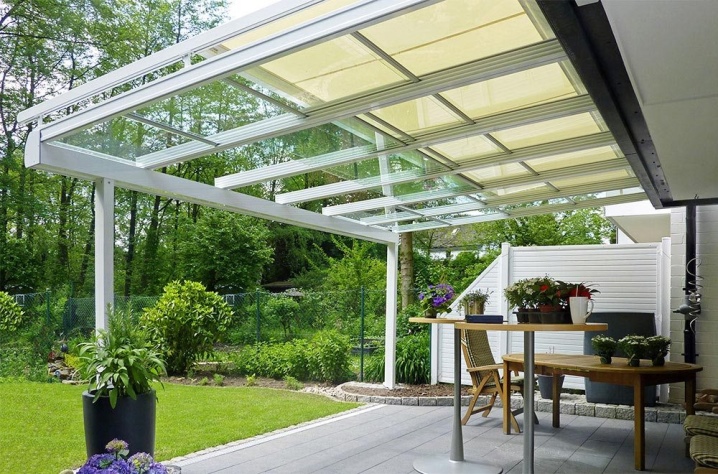
- Most likely, this structure was built simultaneously with the house, but the option of an extension is not excluded.
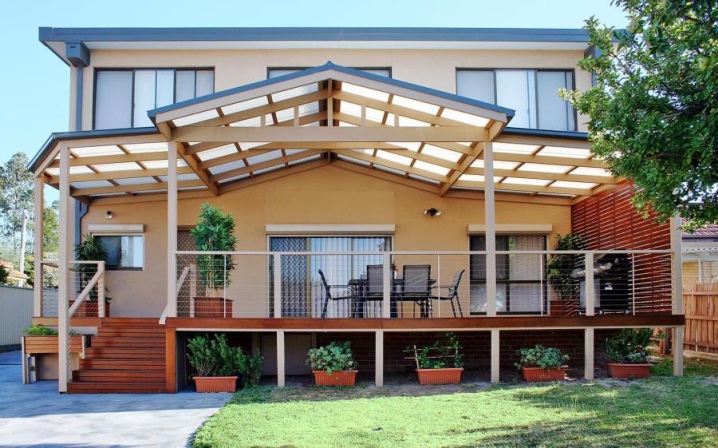
- Country shed for a small house. If it is melted in the sun during gardening work, you can quickly hide under the shade of a canopy, sit down or drink something refreshing.
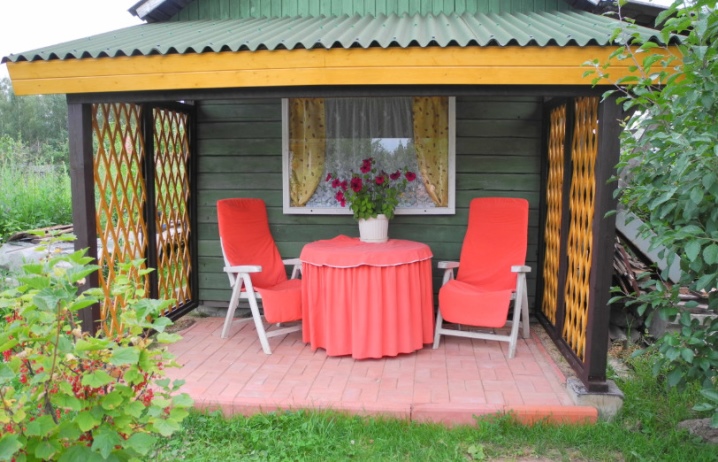
- This suspended place can be multifunctional: here you can arrange home holidays, birthdays, and sometimes completely give this place as a dance floor. Atmospheric lighting will only increase the time spent in this area.

- Small but very comfortable design. This canopy covers the table and chairs, but it is not provided for other tasks.
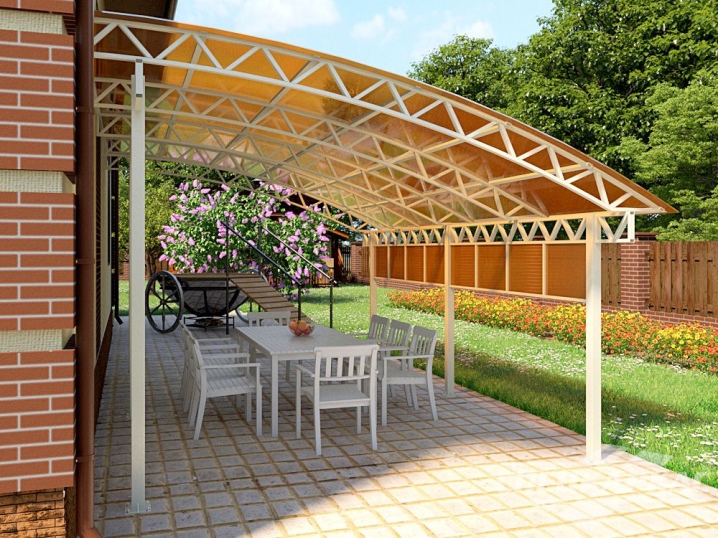
- Almost a veranda created by the extension of the polycarbonate unit. The rain is not terrible here, and there is enough place for relaxation for all households.

- In such a nice house, you want to stay longer, and the canopy and its pillars look very decorative.
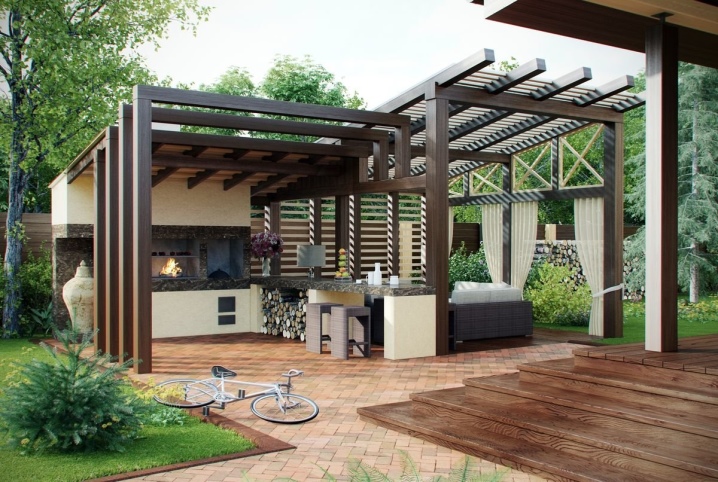
- A gorgeous canopy, a large summer kitchen where you can not only dine, but also cook something delicious in the fresh air.
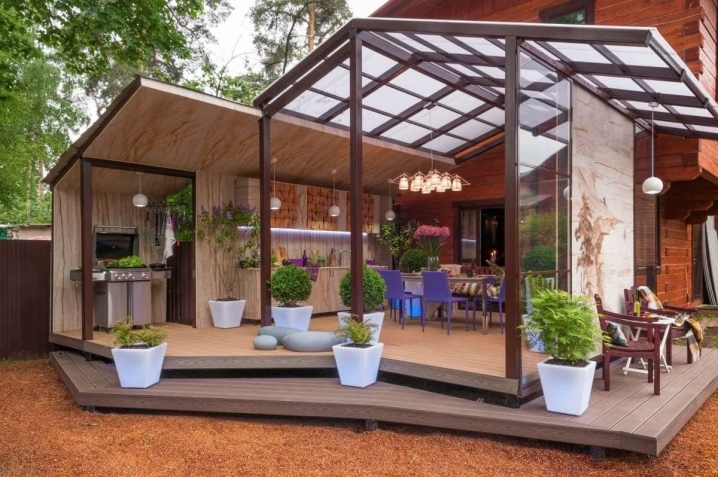
- The structure is made of wood, under which is actually the whole living room. But it looks great!

- Even the most modest house will be transformed with the shown mounted installation, it sets a completely different mood for the territory.
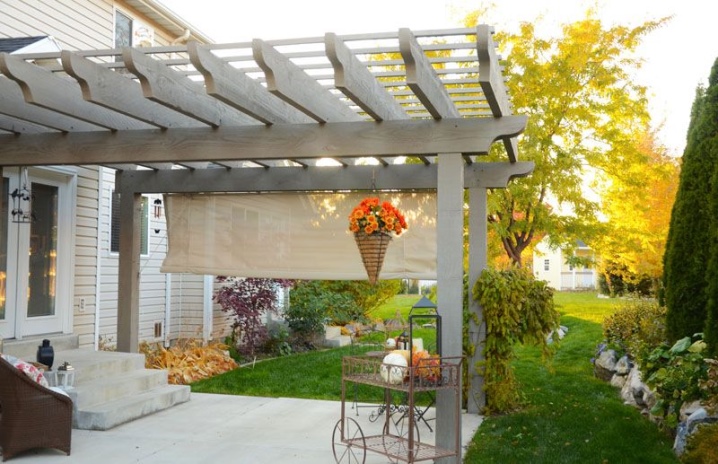
- Following the example of this solution, it can be seen that decorating the canopy with flowers is not difficult, and it can be done even more gracefully.
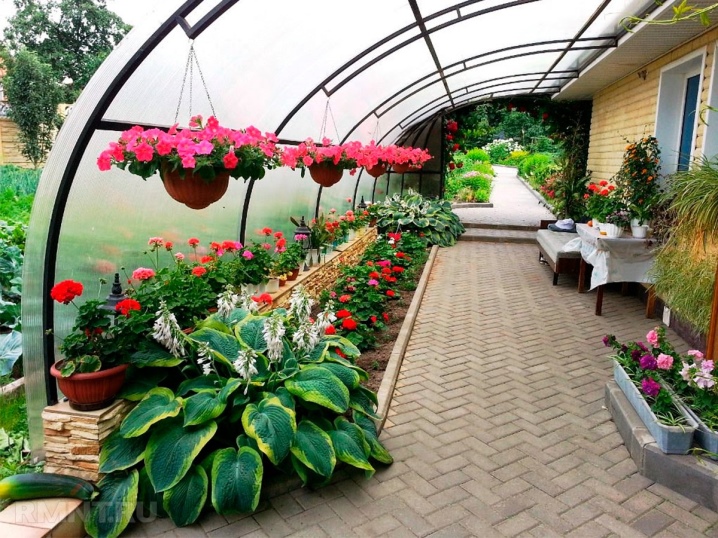
In the next video, you will learn how to make a wooden lean-to shed with your own hands.





























































The comment was sent successfully.